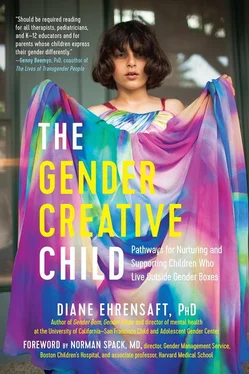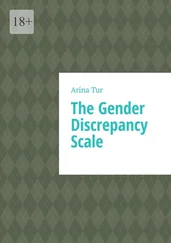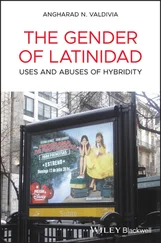How does little Antonio, just entering kindergarten in this small town, spin a gender web? His brain and mind are telling him he is a girl—that constitutes the nature part of his web, albeit both brain and mind are profoundly influenced by the culture in which they grow. His socialization has some gender web threads that don’t match so well: Satya nurtures his right to choose his own gender, just as her homeland’s Supreme Court has asserted. Alfonso is okay with Antonio’s expressing his gender—how he presents himself in the world in clothes, activities, friendship choices, body movements—any way he wants, but when it comes to his child’s gender identity—“Who am I—boy, girl, or other?”—Dad gets a little squeamish. Antonio came into the world as Alfonso’s son, and his father wants to keep it that way. Antonio’s culture threads are as complicated as his parents’: When visiting India, his mother’s country of origin, laws and social movements protect his desire to be the gender he knows himself to be—male, female, or other. When visiting his father’s homeland, Sicily, it is as foreign to them that a boy would be a girl as that a child could identify as a Martian. And at home in the United States, the cultural messages are really very confusing. Antonio and his mom went on the Internet and watched the YouTube video about Ryland, the child who transitioned at age six to his affirmed male identity and received, with his family, the Inspiration Award at the annual Harvey Milk Diversity Breakfast in San Diego, before an audience of one thousand people. That told Antonio that the country he lived in was on board with his becoming the girl he knew himself to be—my goodness, he might even get an award for it. But he also learned that the state he lived in had ruled that boys who said they were girls or girls who said they were boys still had to play on the sports teams that matched the sex assigned to them on their birth certificate. Likewise, the public school Antonio will be attending is gender conservative—organizing many activities by binary gender (boys over here, girls over there). No exceptions allowed.
With all that tangle of threads, here is how five-year-old Antonio wove together his gender web—for now: “I will be a girl at home and a boy at school. I am kind of both, you know. I like wearing dresses, and those will be my weekend clothes, and at school I’ll just wear my skinny jeans and sparkly T-shirts, and people can think I’m whatever they think I am, and if they ask, I’ll say, ‘Boy-girl for now.’ And for pronouns—Just say ‘Antonio’ or ‘Antonio’s,’ don’t say he , don’t say she , don’t say him , don’t say her . I’ll tell my mom that the real truth is that I know I’m all girl, but I’m keeping the boy part for now—it’s just easier. But my dad—well, I’ll just keep to the boy-girl story, because I don’t think he quite gets it yet that boys can really be girls and you can be a girl with a penis.” If we revisit Antonio at age eight, my prediction is that his gender web might look quite different, as he explores and further solidifies both gender identity and gender expression, or alternatively, as Antonio’s gender desires get run underground in the face of social disapproval or rejection.
Now let’s bring in the cousin to the gender web—the true gender self. This is another one of my own inventions, borrowed from the ideas of D. W. Winnicott, a British pediatrician and psychoanalyst who wrote about the three parts of personality development—the true self, the false self, and individual creativity. [18]The true self is the essence and core of our personality; its first kernels are already present at birth, typically known to us as the baby’s temperament. The false self is the coating we put around our true self to comply with the demands of the social environment and to protect the true self from harm. Individual creativity involves the impulse within us to weave together an authentic self, calling both on what comes from within us and what comes toward us from the outside world. Winnicott, always one of my favorite writers and thinkers, guiding me through my clinical work, posthumously offered me a wonderful gift when one day I thought, By golly, I’ve got it. If I take those ideas and transfer them over to the arena of gender, I think I might have a perfect model for understanding how the gender web comes together over time: We have the true gender self, the base of which is evident at birth, but which then goes in so many directions depending on how, in our infancy, we meet up with the social environment and how the social environment meets up with us. In the earliest months and years of life, that social environment will be the mommies, daddies, and primary caregivers of the child, with other family members in a close second place. Then we have the false gender self; that is the protective coating we wrap around our core gender as we meet up with the world and gauge how safe or unsafe it is for the true gender self to come out. Last, we have gender creativity, our endeavors to weave together and hold on to our very own unique and authentic gender self, based on core feelings of identity and chosen gender expressions.
Now, let’s tie together how gender creativity relates to the true gender self and the gender web. Gender creativity is children’s use of fanciful thinking, perseverance, fortitude, and finesse to incorporate the world around them into their inner psyche and their gender as they know it and want it to be. This creativity that allows them to navigate within the gender web and the greater world to discover and be their authentic self is the crux of the true gender self. The job of the adults is to allow a wide berth for this spinning and weaving, mirroring the children’s artistic creations—their gender self—back to them, rather than controlling the motion of the threads and imposing their own gender images on the child. Now that more and more parents and other adults in children’s lives have gotten caught up in the waves of the sea change in gender that swirls all around us, gender creative children have a greater opportunity to come out into the light of day, rather than remaining shrouded in their false gender self while their gender creativity gasps for air. Having read Genny Beemyn and Susan Rankin’s book The Lives of Transgender People , which came out the same year as Gender Born, Gender Made , what moved me most was the repeated story across the nearly 3,500 adults they interviewed. [19]The story went something like this: “If only I had the supports and green light that some of the young children have today, I would have had such a better life. I always knew since I was little that my gender was not what people thought, but there was no place to go with it. So, I had to wait, and wait, with many years of pain and suffering until I could get to the place that was ‘me.’” I both envy and applaud our youngest transgender children. They don’t have to wait to be who they are.
What Do We Know About the Why of Gender?
As we read about the gender web and merge that model with the concept of the true gender self, we can begin to get a sense of the complicated interplay between nature, nurture, and culture for children as they reach for the gender “that is me.” We no longer take it for granted that this is an effortless task, defined simply as learning what it means to be the gender that reflects the sex listed on one’s birth certificate. Since completing Gender Born, Gender Made , I have observed ever-growing attention being given to the biology of gender—what is it in our physiological systems that can create a specific “gender loading”? A recent study of the effects of in utero virilization (exposure to high levels of androgens while in the womb) on girls diagnosed with congenital adrenal hyperplasia (CAH) found, remarkably, that female fetuses exposed to those high levels of androgens and diagnosed with CAH showed higher levels of both cross-gender identifications and cross-gender behaviors than a control group of girls not having had such exposure. The significance of this study is that it suggests, not only for babies diagnosed with CAH, but for all children, that levels of hormone exposure and their absorption by hormone receptors could play a strong role in the gender identity development of a child. [20]In other words, a male fetus receiving high levels of estrogen or a female fetus receiving high levels of androgens may so be tilted toward a gender-nonconforming self in childhood. We could consider this the earliest of environmental effects, but it also settles in as part of the constitutional physiological makeup of the child. Other studies of people diagnosed with disorders of sexual development (DSD) have also found higher levels of gender dysphoria or gender-expansive or transgender identity in these individuals than in the population at large, again suggesting that prenatal and postnatal hormone exposure and absorption have an effect on gender identity. [21]For some time we have been talking about gender not being located between our legs, but between our ears—in our brain and mind. These studies suggest that the particular balance of prenatal “male” and “female” hormone bathing on those little brains and minds, with the nature set of threads strong and center, may very much influence those little children in the spinning of their gender web. I am not saying that there are girl brains and boy brains, but that there are messages sent from the brain about one’s gender that may create a discordance between chromosomes and genitalia, on the one side, and the mental sense of oneself as boy, girl, or other on the other.
Читать дальше












